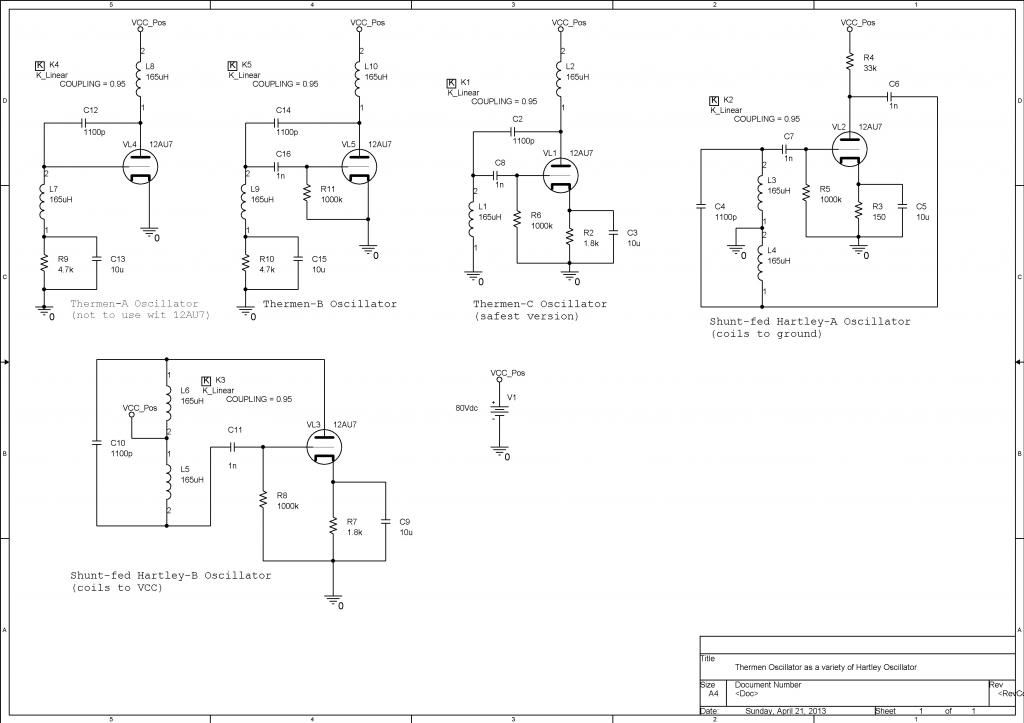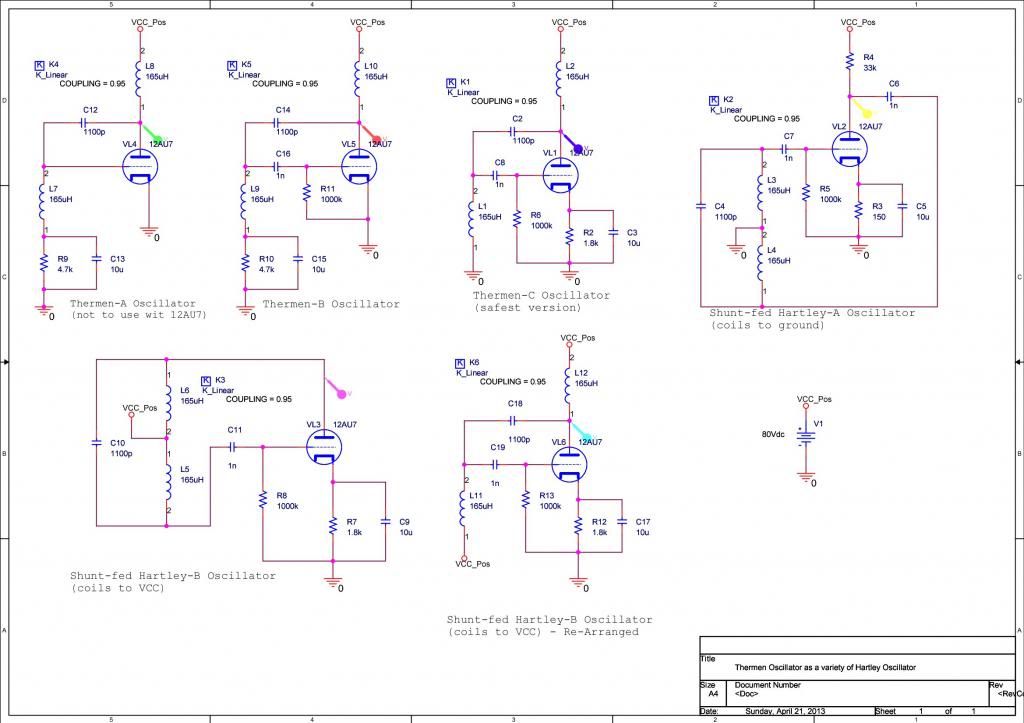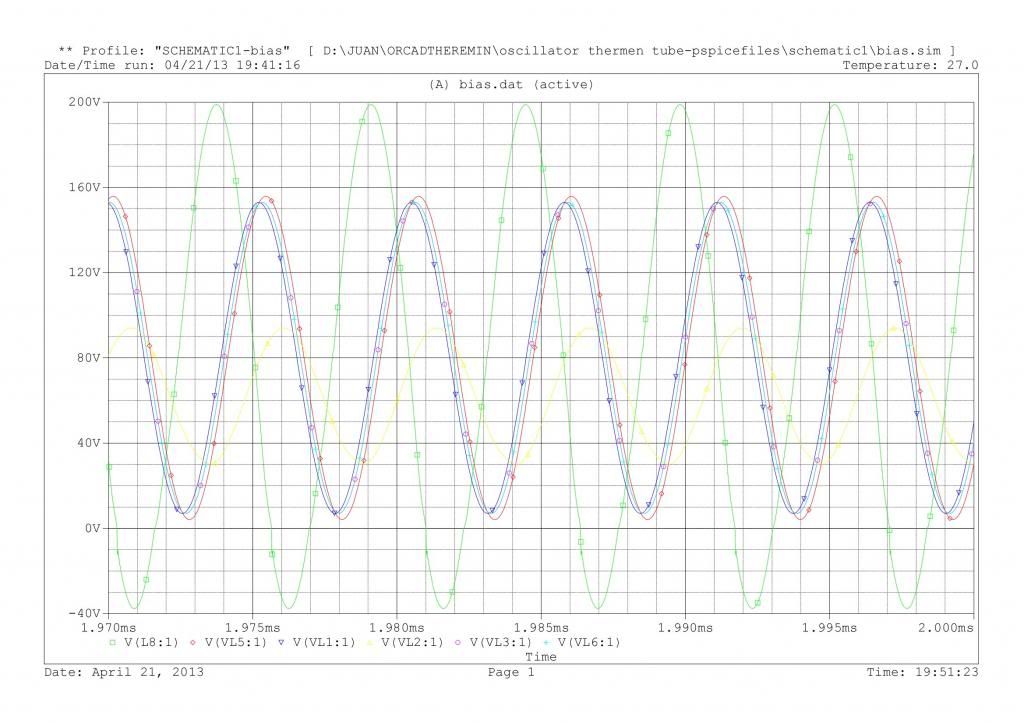Thank you Juan, This is really enlightening research you have presented ! - And from first cursory look at it, I think you are right on your conclusions.
"I think that Fred was wondering if L1 should be equal to L2. This is not a condition for a Hartley oscillator. Usually L1 is lower than L2 (being L1 the coild to the tube anode, and L2 the coil to the control screen). Thermen oscillator feedback being L1=L2 is very high,and in the original configuration control screen positive voltage excursions are terrible for the tube health. The original tube in RCA was a "big bottle" triode, probably quite able to stand big currents in control screen (positive screen voltage in respect to cathode). This is not possible with most of the currently available triodes (such as 12AU7, that probably is good election for a RF oscillator). " - Juan
On my first evaluations / experiments I had L1 and L2 unequal - I only changed to equal inductances due to Charlies posting of a Levnet email from "Uncle Howie", and my wish to explore whether this configuration was beneficial in any way.. I think this email steered the direction (or certainly my direction) away from its original course, and into exploring the Lev theremins, with the object of understanding them and replicating them using semiconductors.
I think one cannot take the oscillator (whatever topology) on its own without including the antenna circuit - and I believe it is here that the "special" qualities of the Lev oscillator ( "shunt-fed magnetic-coupled Hartley oscillators" ) may become significant - And particularly where the construction of the coupled L1/L2 windings becomes important.. I think that perhaps this construction is critical for linearity - my attempts at producing small transformers for L1/L2 have (particularly those on ferrite formers) not given as good results as large air coils more loosely coupled.... But in all, the results are far less spectacular than I first thought.
With regard to over-driving the tubes - I wonder whether this affects the waveshape / harmonic content from these oscillators? If it does, then keeping this "feature" would be important for true replication of the Lev theremin designs, regardless of how achieved.. My focus was on in-mixer waveform shaping, as I believed the mixer was the primary mechanism for the Lev theremins sonic qualities, and the antenna circuit / oscillator the way the famed linearity was achieved.
"I have to conclude that there is a real reason that Termen stuck with this design." - Chobbs
I must agree that I think you are right! - However, with available modern components (and difficulty obtaining the parts Lev used), I no longer think that WE have any real reasonn to stick with Lev's design.
Where I am with this:
For me, its been an exciting diversion - and I learned a lot from it - But I see nothing in the Lev designs which cannot be better implemented using modern components and different topologies.. There is a strong "romantic" pull towards duplicating Lev's theremins using the same topology he did.. But IMO this route is probably folly today.
To me, one wants to duplicate two things from the Lev theremins - You want its responsiveness (linearity / sensitivity etc) and its sound.. It doesnt matter how one gets there - if you achieve these you have a "clone" regardless of whether it uses an analogue subtractive synth engine, or an additive engine, or a sub-sampling theremin or whatever...
And even better if the "Lev clones" are just a set selectable presets amongst a selection of many more presets to include later theremin sounds and synthesisers.. A "Lev Clone Plus" if you like.. With the front-end having modern/new features like adjustable sensitivity (range) and linearity, and register switching.
IMO, the trouble with the theremin is that it has been "imbued" with "qualities" it simply does not posess - All theremins, at the end of the day, right from the first prototype on Lev's bench, output an audio waveform - there are no "mystical" or "fragile" qualities in any waveform - Everything we can hear can be seen and analysed way beyond or ability to hear.. Produce the same audio waveform as the RCA for the same physical actions, and you have a true "RCA Clone" regardless whether the audio is produced by two chickens being heterodyned or by a FPGA.






